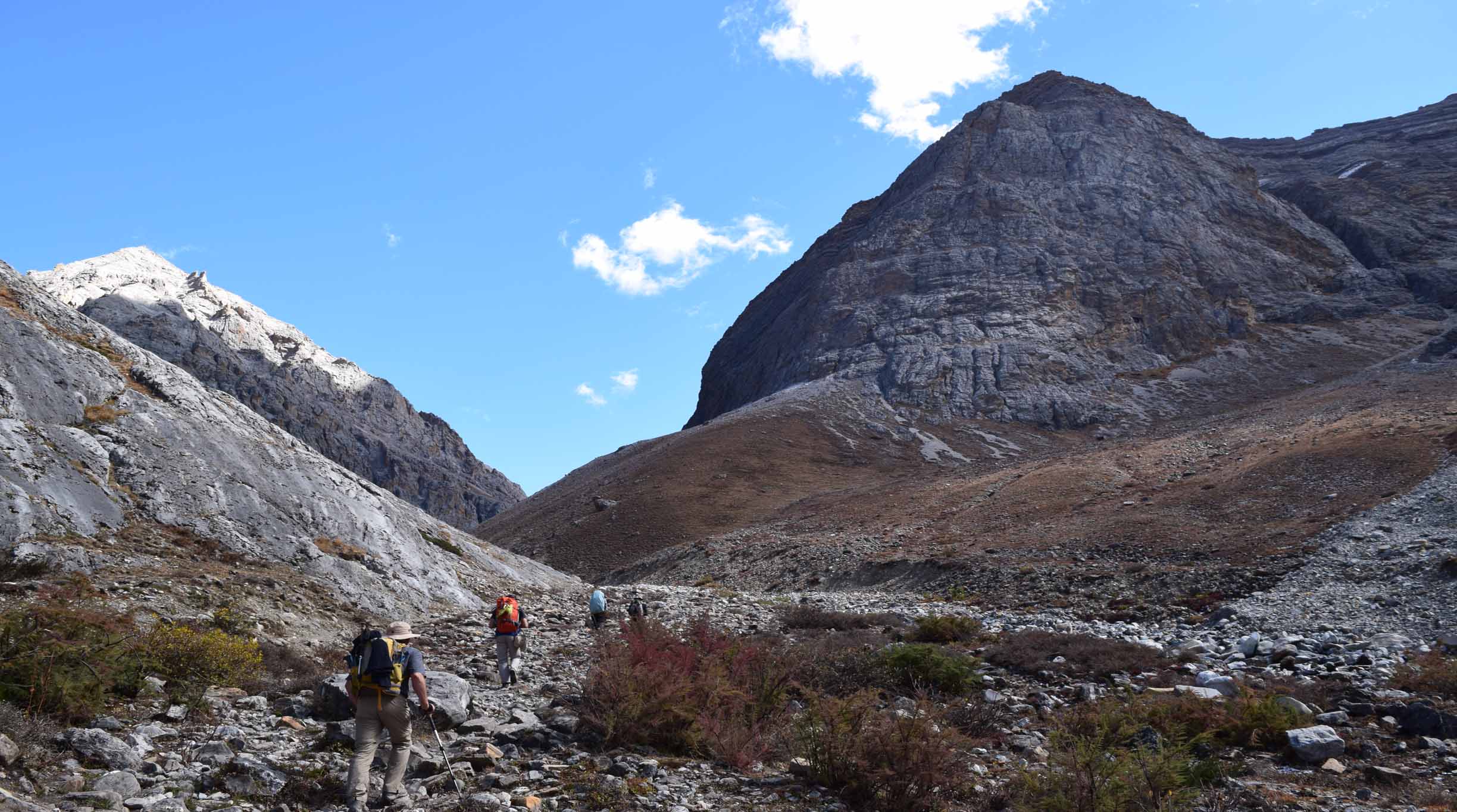GHT West Nepal trek is the longest trekking route of West Nepal. GHT West Nepal trek kicks off from the Simikot capital of a remote Humla district of West Nepal through Mugu and Upper Dolpo to Jomsom of Mustang district.
GHT West Nepal route covers the four districts of West Nepal Humla, Mugu, Dolpo and Mustang of West Nepal. This journey is one of the longest and enthralling journeys of Nepal, where we encounter the lost and wilderness valleys, beautiful isolated remote frontier villages, sculpted gorges, wild canyons, silver shining mountains and peaks, friendly people and their honorable cultures, Tibetan Buddhist and Bon monasteries, amazing river valleys, mind-blowing high land valleys, breathtaking high passes and knee-jerking downhill slopes. At the end, this trek is the lifetime achievement which caters the combined bucket experience of nature, culture, and adventure.
There are two routes to undertake GHT West Nepal (Simikot to Jomsom), one is GHT high route which traverses through remote and last isolated village Nepka, Upper Mugu and Upper Dolpo to Jomsom and another route stretches through Changkheli Lagna, Lower Mugu, Rara Lake, Lower Dolpo and Upper Dolpo to Jomsom.
GHT West Nepal (Simikot to Jomsom) trek High Route
GHT West Nepal (Simikot to Jomsom) trek High Route stretches through the middles hills valleys of Humla to last and isolated remote village Nepka. Rolling few days in the wilderness in alpine valleys of Chungar, Kang La and Take khola connects Mugu village via Mugu Ridge in the first stage. The second stage of trek stretching through the wilderness valleys of Thaju Khola, Chyandi Khola and Takla khola valleys crossing Chyargo La pass, Yala Pass and Nimagyalzen La pass to Pho village of Upper Dolpo.
Leaving Pho village via Yambur La to Bhijer we have two options one goes to Shey Gompa via Tata or Tora the Se la pass to Namgong Gompa to Saldang and another direct leads to Saldang crossing Neng La pass to Saldang village. From Saldang again there are two routes, one direct route to Shimen village via Koma village and another further northern loop along Nisal village Yangjer Gompa and Musi then crossing Musi La pass to Shimen village.
After Shimen village the trail leads along the Panzang River and Panzang valleys' beautiful hamlets Phalwa and Tinje village. Beyond Tinje the trek further rolling into upper Panzang valley and passing Mo La pass to Chharka.
On the last stage after Chharka village, the trail treading through high alpine valleys of Norbulung and Mulumsumna crossing Jungbenla pas to Sanda village and Kagbeni/Phalek/Dagarjung then finally to Jomsom.
GHT West Nepal (Simikot to Jomsom) trek Lower Route
GHT West Nepal (Simikot to Jomsom) trek passes through the lower and middle hill valleys of Humla district crossing Changkheli Lagna via Gamgadi to Rara Lake in the first stage of trek.The second stage of trek treading through forested and middles hills of Jumla acrossing Gurchi Lagna and Jaljala Lagna to Jumla.
The third stage of trek also stretching through middles hills of Jumla via Maure Lagna to Lower Dolpo’s beautiful hamlets Chaurikot, and Hurikot. From Hurikot the trail ascend to alpine meadows and encountering Kagmara La pass 5115m to Pungmo, Ringmo and Phoksundo Lake.
From Phoksundo the trek has two options, one treading through the two high passes Bagala Pass and Numala Pass leads to Dho Tarap and then Chhrka crossing Jyarkoi La 5360m and Mola 5030m pass to Chharka.
Another trail leads to the north of Phoksundo Lake via Kang La pass to Upper Dolpo’s revered valley Shey Gompa. From Shey Gompa further two options; one trail leads to Bhijer via Tata or Tora Samling Gompa to Bhijer village. Then crossing Nengla Pass to Saldang and another direct route via crossing Se La pass to Namgong Gompa and Saldang. From Saldang direct route passes across Koma to Shimen and further looping via Nisal village Yangjer Gompa and Musi village conjones Shimen crossing Musi La Pass.From Shimen the trail following the Panzang valley’s Phalwa and Tinje village through Upper Panzang valley and conquering Mo La pas next is Chharka village.
From Chharka village the trek rolling into the high alpine valleys of Norbulung and Mulumsumna the trail connects Sanda village crossing Niwar La pass, Jungbenla Pass, and Sangda Bhanjyang. Finally, a day trek from Sangda to Kagbeni/Phalek/Dagarjung and ends at Jomsom.
Differences and Similarities in GHT West Nepal (Simikot Jomsom Trek) High Route and Lower Route
Differences in two routes
● Both routes are very interesting and are the part of GHT West Nepal.
● Both routes include Upper Dolpo and Jomsom.
● Both routes are accessed from Simikot and exit from Jomsom.
Similarities in two routes
● In GHT West Nepal Simikot Jomsom Trek High route passes through Upper Mugu valley to Upper Dolpo to Jomsom whereas GHT West Nepal Simikot Jomsom Trek lower passes through Lower Mugu valleys along the Rara Lake, Jumla, Lower Dolpo and Upper Dolpo to Jomsom.
● GHT West Nepal Simikot Jomsom Trek high route a bit strenuous and challenging including than GHT West Nepal Simikot to Jomsom Trek Lower route.
● GHT West Nepal Simikot to Joms Trek Lower route covers two most beautiful Lakes one is the largest ‘Rara Lake’ and another deepest Lake ‘Phoksundo Lake’ whereas GHT West Nepal Simikot to Jomsom Trek Lower route exclude both of Lakes.
Access and exit points of Trek
● Access point for both treks is Simikot airstrip, Humla Simikot which is also known as a gateway to Mt. Kailash.
● Exit point for both treks is Jomsom of Mustang district.
Level of Participant
● This trekking trip is a bit longer which will be FIVE weeks-long journeys in the thin air and a good level of fitness is needed for both of these trips.
● This is a journey to the high frontier wilderness and a good dose of patience, tolerance and humor are needed.
Why with Us?
● We are west Nepal specialized tour operator and native of West Nepal.
● We had organized many novice trekkers in the region and have experienced trekking crews.
● At last but not the least, our priority is on local staffs, so community people will be directly benefited.






